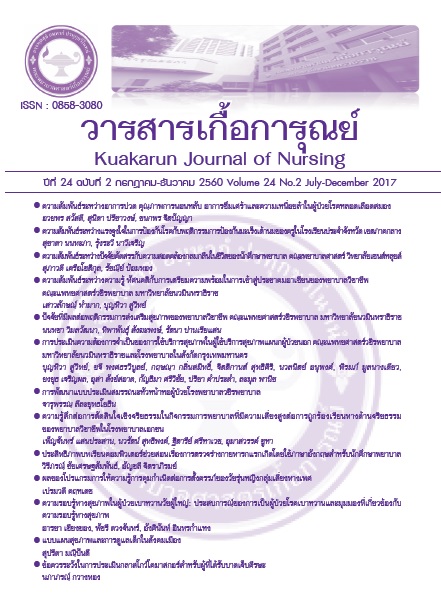Relationships between Pain, Sleep Quality, Depressive Symptoms, and Fatigue in Post Stroke Patients
Main Article Content
Abstract
Abstract
The descriptive correlation research aimed to investigate fatigue in stroke patients and to study the relationships among pain, sleep quality, depressive
symptoms and fatigue in post stroke patients. The conceptual framework was based on the Piper’s Integrated Fatigue Model. A convenient sample of 140 post stroke patients was recruited from the neurology outpatient departments in three tertiary hospitals. All participants responded to a set of five questionnaires: demographic characteristics questionnaire, the Pain scale, the Pittsburgh Sleep Quality Index, the Hospital Anxiety Depression Scale, and the Fatigue Severity Scale. All instruments were tested for content validity by 5 experts, and their reliability were .61, 84, and .92 respectively. Frequency, percentage, mean, standard deviation and Pearson’s correlation were used in data analysis. The study findings can be summarized
as follows:
1. The average Fatigue Severity Scale score for the sample of stroke patients was 4.03 (S.D = 1.43) About 55.70 percent of the sample reported fatigue.
2. Pain, sleep quality, and depressive symptoms were significantly correlated with fatigue in stroke patients (r =.35, r = .53, r = .56; p-value <0 .01)
Article Details
References
ธนา นิลชัยโกวิทย์, มาโนช หล่อตระกูล, และ อุมาภรณ์ ไพศาลสุทธิเดช. (2539). การพัฒนาแบบสอบถาม Hospital Anxiety and Depression Scale ฉบับภาษาไทยในผู้ป่วยโรคมะเร็ง.
วารสารสมาคมจิตแพทย์แห่งประเทศไทย, 41(1), 18-30.
มาโนช หล่อตระกูล. (2544). เครื่องมือประเมินปัญหาสุขภาพจิตและจิตเวช. สืบค้นเมื่อ 14 กุมภาพันธ์ 2557,จาก http://www.ramamental.com/gp/gp31.
สมศักดิ์ เทียมเก่า, ชูศรี คูชัยสิทธิ์, สุกานดา อริยานุชิตกุล, ศศิธร แสงพงศานนท์, สุพจน์ คำสะอาด และ วาสนา จันทะชุม. (2552). คุณภาพชีวิตของผู้ป่วยนอกโรคหลอดเลือดสมอง
ที่โรงพยาบาลศรีนครินทร์. จดหมายเหตุทางแพทย์ แพทยสมาคมแห่งประเทศไทยในพระบรมราชูปถัมภ์, 92(12), 1602-1609.
สมาคมการศึกษาเรื่องความปวดแห่งประเทศไทย.(2552). แนวทางพัฒนาการระงับปวดเฉียบพลัน (Clinical Guidance for Acute Pain Management) (Vol.1). กรุงเทพฯ:
สมาคมการศึกษาเรื่องความปวดแห่งประเทศไทย.
สำนักโรคไม่ติดต่อ กรมควบคุมโรค. (2557). จำนวนและอัตราการตายด้วยโรคหลอดเลือดสมอง ปี 2544 - 2555. สืบค้นเมื่อ 14 กุมภาพันธ์ 2557, จาก http://thaincd.com/informationstatistic/non-communicable-disease-data.php,
Acciarresi, M., Bogousslavsky, J., & Paciaroni, M. (2014). Post-stroke fatigue: Epidemiology, clinical characteristics and treatment. Eur Neurol, 72(5-6), 255-261.
Bassetti, C. L., & Hermann, D. M. (2011). Sleep and stroke. Handb Clin Neurol, 99, 1051-1072.
Cumming, T. B., Thrift, A. G., Collier, J. M., Churilov, L., Dewey, H. M., Donnan, G. A., & Bernhardt, J. (2011). Very early mobilization after stroke fast-tracks return to
walking: Further results from the phase II AVERT randomized controlled trial. Stroke, 42(1), 153-158.
Davis , S., & Norrving, B. (2013). Organizational Update: World Stroke Organization. Stroke, 44(12), e173.
De Groot, M. H., Phillips, S. J., & Eskes, G. A. (2003). Fatigue associated with stroke and other neurologic conditions: Implications for stroke rehabilitation. Arch Phys Med
Rehabil, 84(11), 1714-1720.
Eilertsen, G., Ormstad, H., & Kirkevold, M. (2013). Experiences of poststroke fatigue: Qualitative meta-synthesis. J Adv Nurs, 69, 514-525.
Giacobbe, P. (2010). Post-stroke fatigue: Refining the concept. (Master of Science), University of Toronto, Retrieved from http://books.google.co.th/
books?id=iUk5MwEACAAJ
Krupp, L., LaRocca, N., Muir-Nash, J., & Steinberg, A. (1989). The fatigue severity scale. Application to patients with multiple sclerosis and systemic lupus erythematosus.
Arch Neurol, 46, 1121 - 1123.
Lerdal, A., & Gay, C. L. (2013). Fatigue in the acute phase after first stroke predicts poorer physical health 18 months later. Neurology, 1-7.
Mohsenin, V. (2001). Sleep-related breathing disorders and risk of stroke. Stroke, 32(6), 1271-1278.
Naess, Lunde, L., & Brogger, J. (2012). The effects of fatigue, pain, and depression on quality of life in ischemic stroke patients: The Bergen stroke study. Vasc Health Risk
Manag, 8, 407-413.
Naess, Lunde, L., Brogger, J., & Waje-Andreassen, U. (2010). Post-stroke pain on long-term follow-up: The Bergen stroke study. J Neurol, 257(9), 1446-1452.
Naess, H., Lunde, L., Brogger, J., & Waje-Andreassen, U. (2012). Fatigue among stroke patients on long-term follow-up: The Bergen stroke study. J Neurol Sci, 312(1-2),
138-141.
Naess, H., & Nyland, H. (2013). Poststroke fatigue and depression are related to mortality in young adults: A cohort study. BMJ Open, 3
Piper, B. F. (1993). Fatigue and cancer: Inevitable companions? Supportive Care in Cancer, 1(6), 285-286.
Thondike, R. (1979). Correlation procedures for research. Gardner Press, Inc., New York 1978. Biometrical Journal, 21(4), 403-403.
van de Port, I. G., Kwakkel, G., Schepers, V. P., Heinemans, C. T., & Lindeman, E. (2007). Is fatigue an independent factor associated with activities of daily living,
instrumental activities of daily living and health-related quality of life in chronic stroke? Cerebrovasc Dis, 23(1), 40-45.
Wang, S. S., Wang, J. J., Wang, P. X., & Chen, R. (2014). Determinants of fatigue after First-ever ischemic stroke during acute phase. PLoS One, 9(10), e110037.

